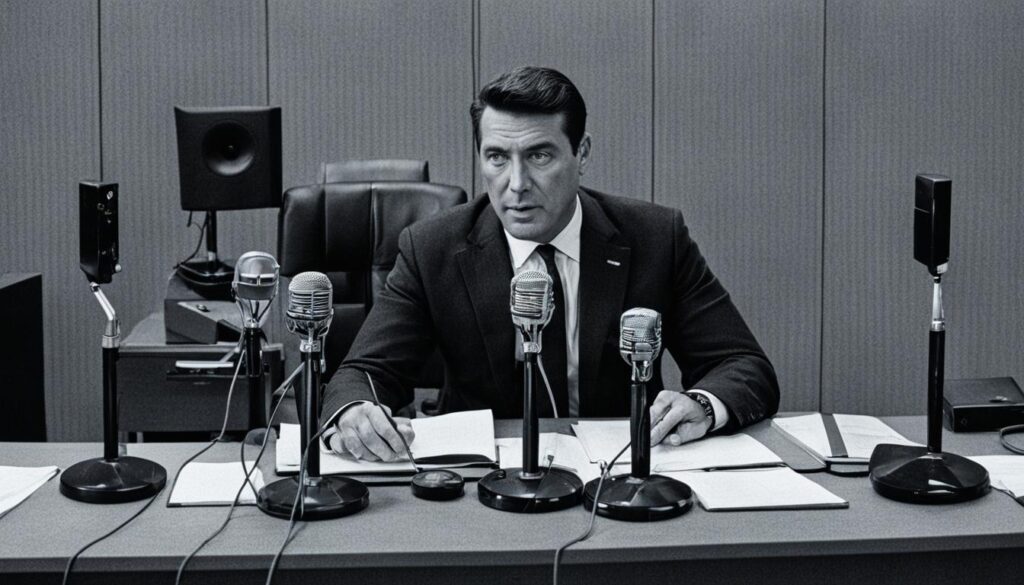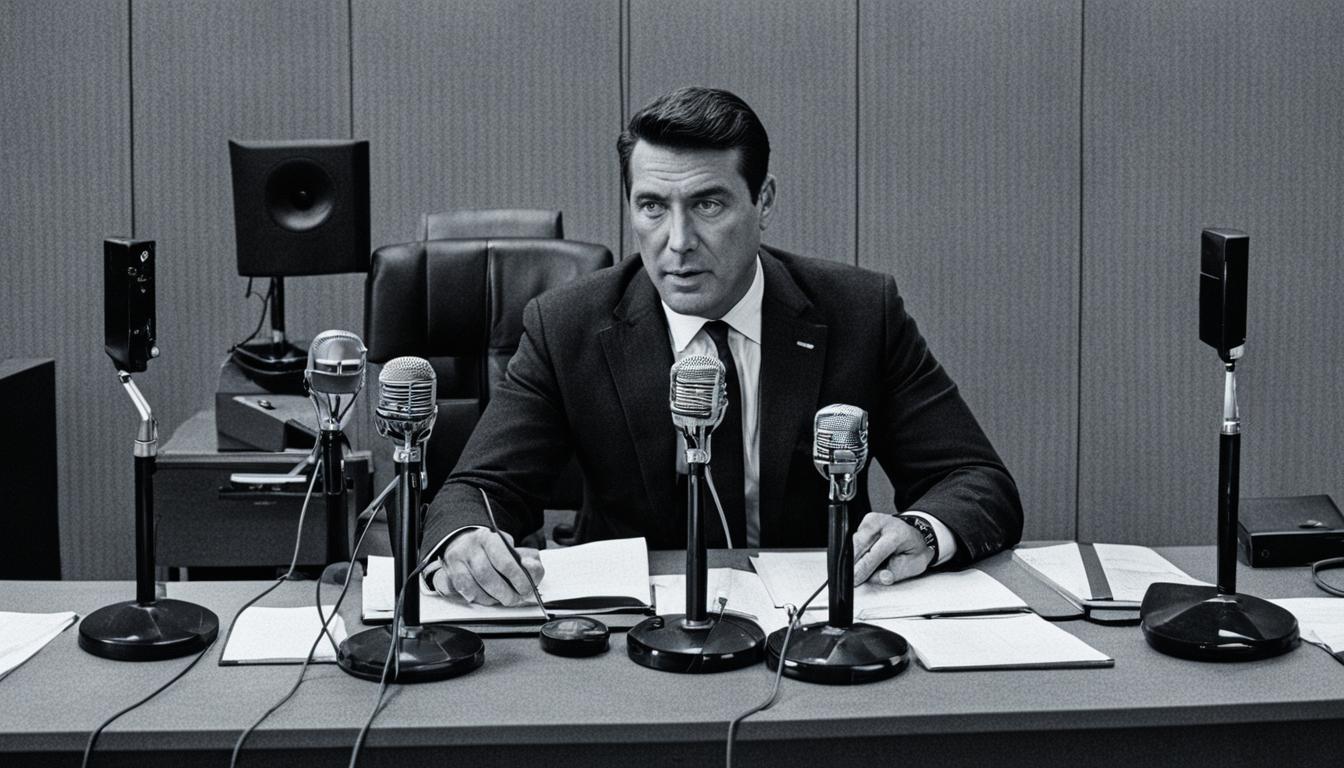As an audiobook narrator, the quality of your recordings is critical in delivering a professional and engaging audiobook experience. To achieve the best possible audio quality, selecting the right microphone is essential. A poor-quality microphone may pick up unwanted background noise, distort your voice, and negatively affect the overall quality of your recording.
In this section, I will discuss the importance of microphone selection for audiobook narration and why it is crucial to invest in a high-quality microphone. I will provide practical guidance on how to choose the right microphone for your specific needs, ensuring clear and professional audio quality in your audiobook recordings.

Key Takeaways:
- Choosing the right microphone is crucial in achieving clear and professional audio quality in your audiobook recordings.
- A poor-quality microphone can negatively affect the overall quality of your recording by picking up unwanted background noise and distorting your voice.
- Investing in a high-quality microphone is essential for audiobook narration.
- Consider factors such as audio quality, budget, background noise, and sensitivity when selecting a microphone.
- Maintaining and caring for your microphone is essential to extend its lifespan and preserve its audio quality.
Understanding the Different Types of Microphones
If you’re new to audiobook narration, it can be overwhelming to select the best microphone for recording. The first step to making an informed decision is by understanding the types of microphones available. There are three main types of microphones used in audiobook recording: condenser, dynamic, and ribbon microphones.
A condenser microphone is highly sensitive and produces clear audio quality. They are great for recording in quiet environments and picking up subtle details, such as breaths and vocal nuances. Dynamic microphones, on the other hand, are less sensitive and better suited for recording in noisy environments. They are also very durable and can withstand accidental drops and bumps. Lastly, ribbon microphones are known for their warm, natural sound that captures the depth and richness of voice. However, they tend to be more expensive and require careful handling.
Choosing the right microphone for your needs depends on several factors, such as your recording environment, vocal style, and budget. Take time to research and test different types of microphones to find the perfect fit for your audiobook narration.
Factors to Consider When Choosing a Microphone
When it comes to selecting a microphone for audiobook narration, there are several factors to consider to ensure optimal audio quality.
First and foremost, audio quality should be your top priority. Look for a microphone that can provide clear and crisp sound that captures the nuances of your voice. A high-quality microphone will make your audiobook sound professional and engaging, captivating your listeners from start to finish.
However, you should also take your budget into consideration. While a top of the line microphone might provide the best audio quality, it might not fit within your budget constraints. Research and compare different microphone models to find one that offers the right balance between affordability and audio performance.
In addition to audio quality and budget, background noise is another crucial factor to consider. Find a microphone that can help minimize background noise, ensuring that your narration is the main focus of the recording.
Lastly, the sensitivity of the microphone is also critical. The microphone needs to be sensitive enough to capture the intricacies of your voice, but not so sensitive that it picks up unwanted noise or vibrations.
When considering all these factors, make sure to do your research and check reviews from other audiobook narrators to find a microphone that best suits your needs and preferences.
Recommended Microphone Models for Audiobook Narration
Choosing the right microphone for audiobook narration can greatly impact the overall audio quality of your recording. After testing various microphone models, I have put together a list of recommended microphones that are ideally suited for audiobook narration.
First on the list is the Audio-Technica AT4053B Hypercardioid Condenser Microphone. This microphone is known for its excellent vocal frequency response and low self-noise, making it an ideal choice for recording audiobooks. Another great option is the Neumann TLM 103 Condenser Microphone, which offers pristine audio quality and a large diaphragm for enhanced sensitivity and clarity.
If you are looking for a budget-friendly option, the Blue Yeti USB Microphone is a great choice, as it offers clear audio recording quality and multiple polar patterns to suit different recording environments. Additionally, the Rode NT1-A Cardioid Condenser Microphone is a popular choice for its low self-noise and impressive dynamic range, making it an excellent option for those on a tighter budget.
For those who prefer a dynamic microphone, the Shure SM7B Cardioid Dynamic Microphone is another great choice for audiobook narration. It offers a smooth, warm sound and excellent background noise rejection to ensure clear and professional audio quality.
Ultimately, the recommended microphone model for audiobook narration will depend on your budget, recording environment, and personal preferences. Take the time to consider your needs and prioritize the key features that are most important to you when selecting a microphone for audiobook narration.
Importance of Microphone Accessories
Using a high-quality microphone alone is not enough to achieve the best audio quality for your audiobook narration. To enhance your sound recording further, you will need microphone accessories such as a pop filter, shock mount, and microphone stand.
A pop filter is an essential accessory that helps reduce popping sounds caused by airflow when pronouncing words containing plosives such as ‘p’, ‘t’, and ‘b’. It works by diffusing the air before it reaches the microphone, resulting in a clearer and more precise sound.
A shock mount is another popular accessory that isolates your microphone from external vibrations, such as footsteps, that can interfere with your audio recording. It suspends the microphone in an elastic support system, reducing unwanted noise and resulting in a smoother audio output.
A microphone stand is also an essential accessory that provides stability and adjustability to your microphone. It allows you to position your microphone at the optimal distance and angle, ensuring optimal recording performance.
Using microphone accessories like these may seem like small details, but they can significantly improve the overall quality of your audiobook recording.
Tips for Microphone Maintenance and Care
As a professional audiobook narrator, maintaining and caring for your microphone is essential to ensure optimal sound quality and longevity. Here are some valuable tips that will help you adequately care for your microphone:
- Keep it clean: Regularly clean your microphone with a soft, dry cloth to remove any dust or debris that may have accumulated.
- Protect it from moisture: Avoid exposing your microphone to moisture, and always store it in a dry environment to prevent rust or corrosion.
- Use a storage case: When not in use, store your microphone in a protective case to prevent any damage from accidental drops or bumps.
- Invest in a pop filter: Using a pop filter can help prevent saliva and other debris from damaging your microphone’s sensitive components.
- Use a shock mount: A shock mount will absorb any vibrations or shocks, further protecting your microphone from damage.
By following these tips, you can increase the lifespan of your microphone and prevent the need for costly repairs or replacements.
“Taking good care of your microphone is crucial to ensuring its longevity and optimal performance. By implementing these tips, you can maintain a high level of audio quality in your recordings and prolong the lifespan of your microphone.”
Testing and Adjusting Microphone Settings
Once you have selected the right microphone for your audiobook narration and set up your recording environment, it’s time to make sure your microphone settings are optimally adjusted for clear and professional audio quality.
The first step is to test your microphone to ensure it is functioning correctly. Speak into the microphone at normal volume and listen back to the recording. If you notice any distortion or background noise, adjust the settings accordingly.
The optimal audio settings will depend on the specific microphone you are using, but generally speaking, you’ll want to adjust the volume and gain level to achieve a clear, even sound. You may also need to adjust the microphone’s polar pattern to reduce any unwanted sounds or ambient noise.
It’s important to also take into account the acoustics of your recording environment. If your recording space is echoey, you may need to adjust your microphone settings accordingly, or consider adding sound-absorbing materials to the room.
Remember to regularly test and adjust your microphone settings as needed to ensure optimal audio quality throughout your recording sessions. By properly testing and adjusting your microphone settings, you can achieve audio recordings that are not only clear and professional but also showcase your unique voice talent.
Final Thoughts and Conclusion
After exploring all the important aspects of selecting the right microphone for audiobook narration, I hope you now have a better understanding of the key factors to consider when making your decision. Remember that the microphone you choose will significantly impact the quality of your audiobook recording, so it’s essential to take your time and make an informed decision.
While there are many factors to consider, such as budget, audio quality, background noise, and sensitivity, ultimately, the right microphone for you will depend on your specific needs and preferences.
By using the recommended microphone models and accessories, properly maintaining and caring for your microphone, and testing and adjusting your microphone settings, you can achieve optimal audio quality for your audiobook recordings.
In conclusion, selecting the right microphone for audiobook narration is a vital aspect of producing high-quality recordings. By investing in a high-quality microphone and accessories and following the maintenance and testing guidelines, you can ensure the best possible sound for your audiobook recordings and take your audiobook narration to the next level.
